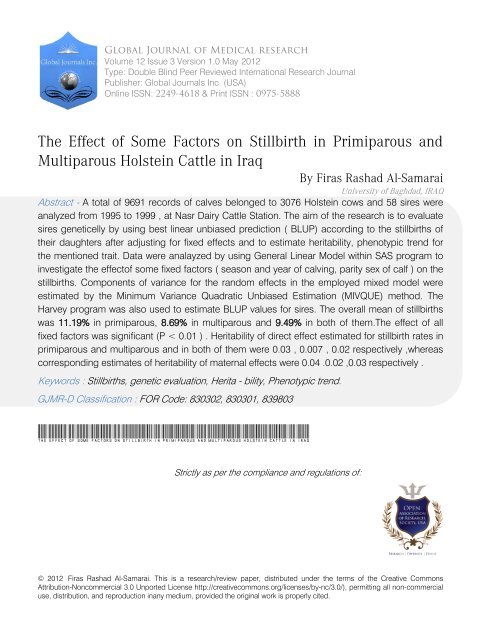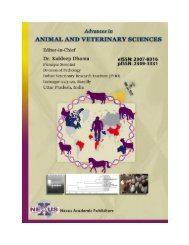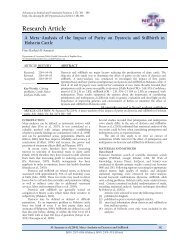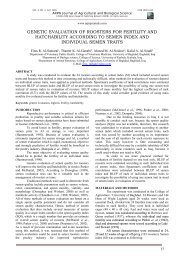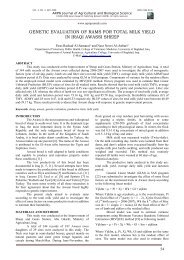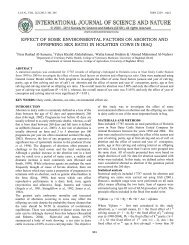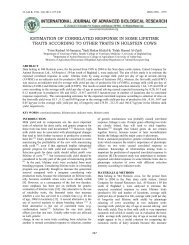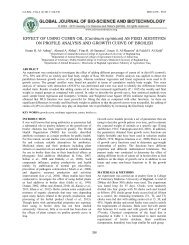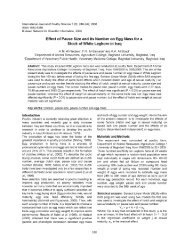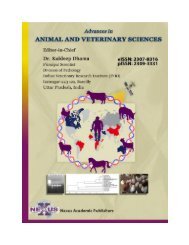o_1924ojiudrqsd1a127mt911tgia.pdf
Create successful ePaper yourself
Turn your PDF publications into a flip-book with our unique Google optimized e-Paper software.
Global Journal of Medical research<br />
Volume 12 Issue 3 Version 1.0 May 2012<br />
Type: Double Blind Peer Reviewed International Research Journal<br />
Publisher: Global Journals Inc. (USA)<br />
Online ISSN: 2249-4618 & Print ISSN : 0975-5888<br />
The Effect of Some Factors on Stillbirth in Primiparous and<br />
Multiparous Holstein Cattle in Iraq<br />
By Firas Rashad Al-Samarai<br />
University of Baghdad, IRAQ<br />
Abstract - A total of 9691 records of calves belonged to 3076 Holstein cows and 58 sires were<br />
analyzed from 1995 to 1999 , at Nasr Dairy Cattle Station. The aim of the research is to evaluate<br />
sires geneticelly by using best linear unbiased prediction ( BLUP) according to the stillbirths of<br />
their daughters after adjusting for fixed effects and to estimate heritability, phenotypic trend for<br />
the mentioned trait. Data were analayzed by using General Linear Model within SAS program to<br />
investigate the effectof some fixed factors ( season and year of calving, parity sex of calf ) on the<br />
stillbirths. Components of variance for the random effects in the employed mixed model were<br />
estimated by the Minimum Variance Quadratic Unbiased Estimation (MIVQUE) method. The<br />
Harvey program was also used to estimate BLUP values for sires. The overall mean of stillbirths<br />
was 11.19% in primiparous, 8.69% in multiparous and 9.49% in both of them.The effect of all<br />
fixed factors was significant (P < 0.01 ) . Heritability of direct effect estimated for stillbirth rates in<br />
primiparous and multiparous and in both of them were 0.03 , 0.007 , 0.02 respectively ,whereas<br />
corresponding estimates of heritability of maternal effects were 0.04 .0.02 ,0.03 respectively .<br />
Keywords : Stillbirths, genetic evaluation, Herita - bility, Phenotypic trend.<br />
GJMR-D Classification : FOR Code: 830302, 830301, 839803<br />
The Effect of Some Factors on Stillbirth in Primiparous and Multiparous Holstein Cattle in Iraq<br />
Strictly as per the compliance and regulations of:<br />
© 2012 Firas Rashad Al-Samarai. This is a research/review paper, distributed under the terms of the Creative Commons<br />
Attribution-Noncommercial 3.0 Unported License http://creativecommons.org/licenses/by-nc/3.0/), permitting all non-commercial<br />
use, distribution, and reproduction inany medium, provided the original work is properly cited.
The Effect of Some Factors on Stillbirth in<br />
Primiparous and Multiparous Holstein Cattle in<br />
Iraq<br />
Firas Rashad Al-Samarai<br />
Abstract - A total of 9691 records of calves belonged to 3076<br />
Holstein cows and 58 sires were analyzed from 1995 to 1999 ,<br />
at Nasr Dairy Cattle Station. The aim of the research is to<br />
evaluate sires geneticelly by using best linear unbiased<br />
prediction ( BLUP) according to the stillbirths of their<br />
daughters after adjusting for fixed effects and to estimate<br />
heritability, phenotypic trend for the mentioned trait. Data were<br />
analayzed by using General Linear Model within SAS program<br />
to investigate the effect of some fixed factors ( season and<br />
year of calving, parity sex of calf ) on the stillbirths.<br />
Components of variance for the random effects in the<br />
employed mixed model were estimated by the Minimum<br />
Variance Quadratic Unbiased Estimation (MIVQUE) method.<br />
The Harvey program was also used to estimate BLUP values<br />
for sires. The overall mean of stillbirths was 11.19% in<br />
primiparous, 8.69% in multiparous and 9.49% in both of<br />
them.The effect of all fixed factors was significant (P < 0.01 ) .<br />
Heritability of direct effect estimated for stillbirth rates in<br />
primiparous and multiparous and in both of them were 0.03 ,<br />
0.007 , 0.02 respectively ,whereas corresponding estimates of<br />
heritability of maternal effects were 0.04 .0.02 ,0.03<br />
respectively .<br />
Phenotypic trend of stillbirths in primiparous was<br />
positive and non significant ( 0.19% / year) whereas negative<br />
and non-significant ( P < 0.05 ) (- 0.11%/year) in multiparous<br />
and in both of them (- 0.07%/year). Minimum and maximum<br />
BLUP values of sires for stillbirths were 7.33 and 10.33%<br />
respectively.<br />
Keywords : Stillbirths, genetic evaluation, Herita -<br />
bility, Phenotypic trend<br />
I. INTRODUCTION<br />
S<br />
tillbirths is a trait that needs more attention<br />
especially because its rates have increased<br />
with Holstein population (Harbers et al.,<br />
2003;Meyer et al.,2000;Berglund et al.,2003;<br />
Hansen et al.,2004). Berglund (1996) reported an<br />
increase in stillbirths in Sweden with the<br />
importation of semen from North American bulls.<br />
The cost of stillbirths to the US dairy industry has been<br />
estimated to be $ 132 million per year ( Thompson et<br />
al.,1981). Meyer et al.,(2000) has revealed that each<br />
year about 7% of Holstein calves in United State die<br />
within 48 h of birth with unknown cause of death and the<br />
Author : Department of Veterinary Public Health, College of Veterinary<br />
Medicine, University of Baghdad, IRAQ.<br />
E-mail : firas_rashad@yahoo.com<br />
replacement of stillborn calves represent a substantial<br />
cost to the dairy industry at more than $125.3 million per<br />
year.<br />
Stillbirths are defined as a calf that dies just<br />
prior to, during,or within 24 to 48 h of parturition with at<br />
least 260 days of gestation.( Philipsson et al.,1979;<br />
Chassange et al., 1999).<br />
Dystocia, difficulty of birth, has been implicated<br />
as the major cause of stillbirths; however, about 50% of<br />
stillborn calves were from unassisted births (Philipsson<br />
1996).<br />
In recent years, many studies have found<br />
stillbirths to be separate trait in primiparous (heifers) and<br />
multiparous (cows) Holstein cattle.( Meyer et<br />
al.,2000;Hansen, 2005; Steinbock et al., 2006).<br />
The genetic variation exists in stillbirths which<br />
consist of two parts:Direct effects (genetic variation in<br />
the calf) and maternal effects (genetic variation in the<br />
dam).The direct effects of stillbirths describe the calf’s<br />
ability to survive birth.This trait is closely related to the<br />
size of the calf.The maternal effects of stillbirths describe<br />
the cow’s ability to give birth to a living calf. Hence<br />
Hansen, (2005) recomonded to take in to acount the two<br />
effects when analysing stillbirths data.<br />
Sires evaluation are almost exclusively based<br />
on field data, which are highly affected by large array of<br />
environmental factors. For this reason, Togashi et<br />
al.,(2004) reported the importance to adjust for<br />
environmental effects in order to accurately estimates of<br />
genetic merit of sires.<br />
The genetic variation of stillbirths can be<br />
expressed by evaluated sires using Best Linear<br />
Unbiased Prediction (BLUP) after adjustting to<br />
environmental effects.<br />
The aim of the present study is to evaluate sires<br />
using BLUP, estimate heritability for direct and maternal<br />
effects of stillbirths, and to determine the phenotypic<br />
trend of the previous trait in Holstein cattle in Iraq.<br />
II.<br />
MATERIAL AND METHODS<br />
Stillbirths data consist of 9691 records for the<br />
period from1990 to1999 which represent progeny of 58<br />
Holstein sires were used in this study in Nasr Dairy<br />
Cattle Station United Company for Animal Resources<br />
Ltd. This station was established in 1987 in Al-Soueira<br />
(50 km south of Baghdad) Iraq. The herd was imported<br />
M ay 2012<br />
23<br />
Global Journal of Medical Research Volume XII Issue III Version I<br />
© 2012 Global Journals Inc. (US)
The Effect of Some Factors on Stillbirth in Primiparous and Multiparous Holstein Cattle in Iraq<br />
M ay 2012<br />
24 2<br />
Global Journal of Medical Research Volume XII Issue III Version I<br />
as 1200 pregnant Holstein heifers from the United<br />
States of America. All calves were the outcome of an<br />
artificial insemination. Records without information on<br />
season of birth, year of birth, sex of calf and parity were<br />
not included in the analyses .Records where the calf<br />
was not the result of single born were excluded. After<br />
these edits, the final data set included information on<br />
stillbirths was 9691.In this study, we defined calves as<br />
stillborn if they were recorded dead at birth or dead<br />
within 24 to 48 h after births, whereas the others were<br />
considered live-born. We assigned the value 0 for liveborn<br />
and 1 for stillborn calves.<br />
III.<br />
STATISTICAL ANALYSIS<br />
General Linear Model (GLM) within SAS<br />
program was used by using three models: the first one<br />
was used to investigate the effect of season and year of<br />
calving, parity and sex of calf on the stillbirths in<br />
primiparous and multiparous cows. In addition to use<br />
the same model after excluding the data of primiparous<br />
cows to investigate the effects of the previous factors on<br />
multiparous cows.<br />
Y ijklm = µ + E i + R j + P k +S l + e ijklm<br />
Where Y ijkm is any trait considered in this<br />
th<br />
study, µ is the overall mean,Ei the fixed effect of i<br />
th<br />
calving season (i= 1 – 4), Rj the fixed effect of j<br />
th<br />
calving year (j=1990-1999),Pk the fixed effect of k<br />
parity ( k=1 – 6 ), Sl the fixed effect of l th sex( l=1<br />
– 2), e ijk is the residual effect.<br />
The second model used all factors in the<br />
first model but the data for parity from 2 to 6 were<br />
excluded to study the effect of the factors on<br />
stillbirths in primiparous only.<br />
Y ijkl = µ + E i + R j +S k + e ijkl<br />
Third model was used to estimate<br />
component of variance for the random effects<br />
using the Minimum Variance Quadratic Unbiased<br />
Estimation (MIVQUE) method (Rao, 1971).<br />
Y ijklmo = µ + E i + R j + P k +S l + D m + e ijklmo<br />
Where Dm the random effect of sires.<br />
Heritability of direct effect (h²a) was estimated<br />
by paternal half sibs, whereas heritability for maternal<br />
effect was estimated by submitting the following<br />
equations (Cameron, 1997):<br />
σ²P = σ²a + σ²m + σ²E<br />
σ²S = ¼ σ²a<br />
σ²a = 4 σ²S<br />
σ²D = ¼ σ²a + σ²m<br />
σ²D = σ²S + σ²m<br />
σ²m = σ²D – σ²S<br />
σ²E = σ²e – 2 σ²S<br />
h² m= σ²m / σ²P<br />
Where σ²P = Phenotypic variance, σ²a =<br />
Additive variance, σ²m = Maternal variance, σ²E =<br />
Variance due to permanent environment, σ²S =<br />
Variance due to sire, σ²D = Variance due to dam, σ²e=<br />
Residual variance.<br />
BLUP of sires was estimated by Harvey<br />
program (1990).Regression of phenotypic value of<br />
stillborn calves on their birth year was used to estimate<br />
stillbirth phenotypic trend (Galbraith, 2003).<br />
IV.<br />
RESULTS AND DISCUSSION<br />
The overall mean of stillbirths for cows (<br />
primiparous and multiparous) was 9.49% (Table 1), the<br />
present estimation is within range obtained from many<br />
researches 4.55 – 11.8% (Agerholm et al.,1993;<br />
Chassagne et al.,1999; Meyer et al.,2000; Heins et<br />
al.,2005 ), whereas overall mean of multiparous was<br />
8.69 % ( Table 2), and 11.19 % for primiparous (Table<br />
3).This finding was supported by Aurant (1972) who<br />
reported that rate of stillbirths was 50 % higher in<br />
primiparous compared with multiparous and Bar-<br />
Anan et al.,(1976) revealed that stillbirths percentage<br />
was 9.1% and 4.1% in primiparous and multiparous<br />
respectively.<br />
The results of stillborn heifers, cows, and of<br />
both of them are presented in Tables 4, 5 and 6.<br />
The effect of calving season on stillbirths for all<br />
traits was significant (P < 0.01). The highest estimates<br />
were in summer calving being 14.60% in heifers, 10.71%<br />
in cows and 11.36% in both, but the lowest estimates<br />
were in winter calving. These results were supported by<br />
many researches (Bar-Anan et al., 1976; Lindstrom and<br />
Villa 1977; Martinez et al., 1983;Erf et al.,1990; Meyer et<br />
al., 2001).The cause of differences as a result of calving<br />
season may attribute to variation in temperatures,<br />
diseases and nutrition.<br />
The percentage of stillbirths differ significantly<br />
by year of calving which is in agreement with some<br />
studies (Berglund, 1996; Meyer et al., 2001; Hansen et<br />
al., 2004).This finding was interpreted to be a reflect of<br />
differences in management among years.<br />
Parity has a significant effect on stillbirths. This<br />
corresponds well with what has been recorded by two<br />
separate studies in Holstein submitted in the United<br />
States of America: the first one was by Martinez et al.,<br />
(1983) who reported that the stillbirths in the first, the<br />
second and the third calving were 10.5, 5.5 and 5.7%<br />
respectively, and the second was by Meyer et al., (2000)<br />
who revealed that stillbirths were 11% in the first calving<br />
and 5.7% in the second calving.<br />
Sex of calf had a significant effect on stillbirths<br />
percentage. Female calves had lowest estimates being<br />
5.51% in heifers, 5.42% in cows and 7.54% in both. On<br />
the other hand the corresponding estimates of male<br />
were 12.48, 15.15 and 12.76% respectively. The results of<br />
the present study were similar to some other results<br />
obtained by Aurant, (1972), Martinez et al., (1983) and<br />
© 2012 Global Journals Inc. (US)
The Effect of Some Factors on Stillbirth in Primiparous and Multiparous Holstein Cattle in Iraq<br />
Eriksson et al., (2004).The sex of calf may cause a<br />
variation in stillbirths percentage especially in cows with<br />
large body size like Holstein, which is in general, calved<br />
a large size calf and so the probability of dystocia<br />
increased and consequently the stillborns increased<br />
also, due to the high correlation between the two traits<br />
(Lindstrom and Vilva, 1977).<br />
Estimates of heritability of stillbirths are given in<br />
Table 7.In general, all estimates were low. They reflect<br />
the importance of environment effects as an essential<br />
source in phenotypic variation of the studied traits.<br />
The heritability of direct effect (h²a) for stillbirths<br />
was 0.03 in heifers which is within range of 0.00 – 0.05<br />
reported by many researches (Philipsson et al., 1979;<br />
Eriksson et al., 2004; Hansen, 2005; Steinbock et al.,<br />
2006), whereas the h²a in cows was 0.007 and also<br />
comes within range of 0.00 – 0.02 (Philipsson et al.,<br />
1979; Eriksson et al., 2004; Hansen, 2005).On the other<br />
hand h²a of both heifers and cows was 0.02. As shown<br />
in this study, heritability of stillbirths is very low,<br />
particularly in cows (0.007); therefore, direct selection<br />
against stillbirths would relatively be ineffective. Many<br />
advantages could be provided if we selected other traits<br />
which were correlated genetically with stillbirths and had<br />
higher heritability.<br />
The heritability estimates of maternal effects<br />
(h²m) for stillbirths were 0.04 in heifers, 0.02 in cows and<br />
0.03 in both of them, which were similar to estimates<br />
reported by Hansen, (2005) and Steinbock et al., (2006).<br />
Genetic evaluation of sires for stillbirths in<br />
heifers and cows using BLUP values was done and<br />
sires were ranked in descending order. The lowest and<br />
highest values are 7.33% and 10.33% respectively. This<br />
result states that there is a little genetic variation in the<br />
trait, and most variations belonged to environment<br />
effects. A similar result was obtained from Harbers et al.,<br />
(2000) who reported that transmitting ability of sires for<br />
stillbirths was between -3% and 3%.<br />
Phenotypic trend of stillbirth rates in heifers for<br />
the period from 1990 to 1999 was positive and not<br />
significant (0.19% / year), negative and not significant for<br />
cows (- 0.11% / year) and both of them (- 0.07% / year)<br />
(Table 8).This finding was not supported by many<br />
researchers (Harbers et al., 2000; Meyer et al., 2000:<br />
Hansen, 2005) who reported positive and significant<br />
phenotypic trend in stillbirth rates.<br />
V. CONCLUSION<br />
1- Highly significant effects (P < 0.01) on stillbirths were<br />
found for several environmental variables including<br />
calving year, calving season, parity and calf sex.<br />
Therefore, the effects of environmental must be taken<br />
into consideration by adjusting data for these<br />
variables to provide the best estimates of genetic<br />
values and heritability.<br />
2- Heritability estimates for stillbirths obtained for<br />
Holstein population in this study were low which were<br />
pointed to the low role of additive variation in total<br />
variation of stillbirths.<br />
3- The phenotypic trend of stillbirths in this study was<br />
non-significant. This suggested low efficiency of<br />
animal evaluation procedures used in the herd<br />
studied.<br />
4- Further investigation of relationship between stillbirth<br />
rates and other calving traits (dystocia, calving ease)<br />
is needed to develop a more complete<br />
understanding of biological processes resulting in<br />
the loss of calves at birth.<br />
VI. ACKNOWLEDGEMENTS<br />
This study would not have been possible<br />
without the support of Dr. S.S.Kalaf the manager of Nasr<br />
Dairy Cattle Station United Company for Animal<br />
Resources Ltd.The author acknowledge his cooperation<br />
in access to the farm records.<br />
REFERENCES RÉFÉRENCES REFERENCIAS<br />
1. Agerholm J.S., Basse A.,Krogh H.V.,Christensen K.<br />
and Ronsholt L.1993. Abortion and calf mortality in<br />
Danish cattle herd.Acta Vet.Scand.34:371 – 377.<br />
2. Aurant T.1972.Factors affecting the frequency of<br />
stillbirths and postnatal calf losses.J.Anim.Sci.26:941<br />
– 947.<br />
3. Bar-Anan R., Soller M. and bowman<br />
J.C.1976.Genetic and environmental factors affecting<br />
the incidence of difficult calving and prenatal calf<br />
mortality in Israeli – Friesian dairy<br />
herd.Anim.Prod.22:299 – 304.<br />
4. Berglund B.1996.Ongoing research on the causes of<br />
variation in calving performance and stillbirths in<br />
Swedish dairy cattle.Interbull Bull.12:78 – 83.<br />
5. Berglund B., Steinbock L.and Elvander<br />
M.2003.Causes of stillbirth and time of death in<br />
Swedish Holstein calves examined post mortem.Acta<br />
Vet.Scand.44:111 – 120.<br />
6. Cameron N.D.(1997).Selection indices and<br />
production of genetic merit in animal breeding .Cat<br />
International .UK.<br />
7. Chassagne M.,Barnouin J.,Chacornce J.P.1999.Risk<br />
factors for stillbirth in Holstein heifers under field<br />
conditions in France: a prospective survey.<br />
Theriogenology. 51:1477 – 1488.<br />
8. Erf D.F., Hansen L.B. and Neitzel R.R. 1990.<br />
Inheritance of calf mortality for Brown Swiss<br />
cattle.J.Dairy Sci.73:1130 – 1134.<br />
9. Eriksson S., Nasholm A., Johansson K. and<br />
Philipsson J.2004.Genetic parameters for calving<br />
difficulty, stillbirth, and birth weight for Herford and<br />
Charolais at first and later parities.J.Anim.Sci.82:375<br />
– 383.<br />
10.Galbraith F.2003. Genetic evaluation of longevity in<br />
Ayrshire and Jersey dairy cattle using a random<br />
regression model. M.Sc. Univ. of Guelph, Ontario,<br />
Canada. (Thesis).<br />
M ay 2012<br />
25<br />
Global Journal of Medical Research Volume XII Issue III Version I<br />
© 2012 Global Journals Inc. (US)
The Effect of Some Factors on Stillbirth in Primiparous and Multiparous Holstein Cattle in Iraq<br />
M ay 2012<br />
26 2<br />
Global Journal of Medical Research Volume XII Issue III Version I<br />
11.Hansen M.2005. Genetic possibilities to reduce calf<br />
mortality.The 26 th European Holstein and Red<br />
Holstein Conference, Prague.Session.3. Page 1 – 7.<br />
12.Hansen M., Misztal I., Lund M.S., Pedersen J. and<br />
Christensen L.G. (2004). Undesired phenotypic and<br />
genetic trend for stillbirth in Danish Holsteins.J.Dairy<br />
Sci.87: 1477 – 1486.<br />
13.Harbers A., Segeren L. and Jong G. de.2000.Genetic<br />
parameters for stillbirth in the Netherlands.Interbull<br />
Bull.25:117 – 122.<br />
14.Harvey W.R.1990.Mixed Model Least-squares and<br />
Maximum Likelihood Computer Program.User’s<br />
Guide for LSMLMW.The Ohio State University,<br />
Columbus, Ohio.<br />
15.Heins B.J.,Hansen L.B. and Seykora<br />
A.J.2005.Crossbreds of Normande – Holstein , Montbeliarde<br />
– Holstein, and Scandinavian Red – Holstein<br />
Compared to pure Holsteins for dystocia and<br />
stillbirths. University of Minnesota, St.Paul.J.Dairy<br />
Sci.88 (Suppl.1):96. (Abstr.).<br />
16.Lindstrom U.B., and Vilva V.1977.Frequency of<br />
stillborn calves and its association with production<br />
traits in Finnish cattle breeds.Z.Tierz.<br />
Zuchtungsbiol.94:27 – 35 (cited by Erf et al., 1990).<br />
17.Martinez M.L., Freeman A.E. and Berger<br />
P.J.1983.Genetic relationship between calf livability<br />
and calving difficulty of Holsteins.J.Dairy Sci.66:1494<br />
– 1502.<br />
18.Meyer C.L., Berger P.J. and Koehler K.J. 2000.<br />
Interactions among factors affecting stillbirths in<br />
Holstein cattle in the United States. J.Dairy<br />
Sci.83:2657 – 2663.<br />
19.Meyer C.L., Berger P.J. and Koehler K.J.,<br />
Thompson J.R. and Satter C.G.2001. Phenotypic<br />
trends in incidence of stillbirth for Holsteins in the<br />
United States.J.Dairy Sci.84:515 – 523.<br />
20.Philipsson J.1996.Strategies to reduce problems in<br />
calving performance and stillbirths by selection and<br />
differential use of bulls.Proc.Int.Workshop on Genet.<br />
Improvement of Functional Traits in Cattle, Gemloux,<br />
Belgium.Interbull Bull.12:65-71.<br />
21.Philipsson J., Foulley J.L., ederer J.L., Liboriussen T.<br />
and Osinga A.1979.Sire evaluation standards and<br />
breeding strategies for limiting dystocia and stillbirth<br />
.Lives.Prod.Sci.6:111 – 127.<br />
22.Rao C.R.1971.Minimum variance quadratic unbiased<br />
estimation of variance component. J. Multivariate<br />
Analysis.1:445-456.<br />
23.SAS.2001.SAS/STAT Users Guide for Personal<br />
Computer. Release 6.18.SAS Institute, Inc., Cary,<br />
N.C., USA.<br />
24.Steinbock L., Johansson K.,Nasholm A. ,Berglund B.<br />
and Philipsson J.2006.Genetic effects on stillbirth<br />
and calving difficulty in Swedish Red dairy cattle at<br />
first and second calving. Acta Agric.Scand.56:65 –<br />
72.<br />
25.Thompson J.R., Freeman A.E.P., Berger P.J. and<br />
Martinez M.L.1981.A survey of calf mortality in five<br />
dairy breeds. J. Dairy Sci.64 (Supl.1): 1164 (Abstr.).<br />
26.Togashi K., Lin C.Y., Yokouchi K.2004.Overview of<br />
genetic evaluation in dairy cattle. Anim. Sci.J. 75:275<br />
– 284.<br />
Table 1 : Least squares means ± S.E for some factors affecting stillbirths in heifers and cows.<br />
Factors No. of observations Least squares means ± S.E<br />
Overall mean 9691 9.49 ± 0.30<br />
Calving season<br />
Winter 2606 6.81 ± 0.66 c<br />
Spring 1907 9.53 ± 0.76 ab<br />
Summer 2457 11.36 ± 0.67 a<br />
Autumn 2721 8.83 ± 0.64 c<br />
Calving year<br />
1990 329 10.26 ± 1.68 ab<br />
1991 332 8.19 ± 1.66 ab<br />
1992 372 7.88 ± 1.56 ab<br />
1993 681 7.73 ± 1.17 b<br />
1994 871 9.16 ± 1.03 ab<br />
1995 984 11.05 ± 0.97 a<br />
1997 1521 7.23 ± 0.79 b<br />
1998 1743 10.37 ± 0.73 ab<br />
1999 1842 7.82 ± 0.72 ab<br />
© 2012 Global Journals Inc. (US)
The Effect of Some Factors on Stillbirth in Primiparous and Multiparous Holstein Cattle in Iraq<br />
Parity<br />
1 3076 11.35 ± 0.56 a<br />
2 2398 7.59 ± 0.64 b<br />
3 1695 8.59 ± 0.76 b<br />
4 1072 9.58 ± 0.94 b<br />
5 794 8.44 ± 1.19 b<br />
6 656 9.26 ± 1.10 b<br />
Calf sex<br />
Male 5096 12.76 ± 0.51 a<br />
Female 4595 5.51 ± 0.53 b<br />
Means in the same column with no common superscripts differ significantly (P < 0.01).<br />
Table 2 : Least squares means ± S.E for some factors affecting stillbirths in cows<br />
Factors No. of observations Least squares means ± S.E<br />
Overall mean 6615 8.69 ± 0.35<br />
Calving season<br />
Winter 1679 6.29 ± 0.78 b<br />
Spring 967 10.62 ± 0.99 a<br />
Summer 1903 10.71 ± 0.77 a<br />
Autumn 2066 8.19 ± 0.74 ab<br />
Calving year<br />
1990 136 8.61 ± 2.49 ab<br />
1991 176 10.82 ± 2.18 ab<br />
1992 259 7.88 ± 1.80 ab<br />
1993 384 8.10 ± 1.48 b<br />
1994 549 9.80 ± 1.24 ab<br />
1995 732 10.81 ± 1.08 a<br />
1996 665 11.51 ± 1.12 a<br />
1997 984 7.58 ± 0.93 b<br />
1998 1308 10.17 ± 0.81 ab<br />
1999 1422 7.21 ± 0.79 b<br />
Parity<br />
2 2398 7.76 ± 0.64 a<br />
3 1695 8.97 ± 0.76 a<br />
4 1072 9.77 ± 0.94 a<br />
5 794 8.69 ± 1.18 a<br />
6 656 9.57 ± 1.10 a<br />
Calf sex<br />
Male 3501 12.48 ± 0.48 a<br />
.<br />
Female 3114 5.42 ± 0.52 b<br />
M ay 2012<br />
27<br />
Global Journal of Medical Research Volume XII Issue III Version I<br />
Means in the same column with no common superscripts differ significantly (P < 0.01).<br />
© 2012 Global Journals Inc. (US)
The Effect of Some Factors on Stillbirth in Primiparous and Multiparous Holstein Cattle in Iraq<br />
M ay 2012<br />
28 2<br />
Global Journal of Medical Research Volume XII Issue III Version I<br />
Table 3 : Least squares means ± S.E for some factors affecting stillbirths in heifers<br />
Factors No. of observations Least squares means ± S.E<br />
Overall mean 3076 11.19 ± 0.58<br />
Calving season<br />
Winter 927 8.97 ± 1.13 b<br />
Spring 940 9.89 ± 1.12 b<br />
Summer 554 14.60 ± 1.43 a<br />
Autumn 655 11.92 ± 1.29 ab<br />
Calving year<br />
1990 193 13.40 ± 2.34 a<br />
1991 156 8.07 ± 2.58 b<br />
1992 113 9.65 ± 3.02 ab<br />
1993 297 9.10 ± 1.90 b<br />
1994 322 11.05 ± 1.89 ab<br />
1995 252 13.03 ± 2.11 a<br />
1996 351 13.48 ± 1.71 a<br />
1997 537 10.26 ± 1.39 ab<br />
1998 435 12.78 ± 1.55 ab<br />
1999 420 11.63 ± 1.57 ab<br />
Calf sex<br />
Male 1595 15.15 ± 0.86 a<br />
Female 1481 7.54 ± 0.89 b .<br />
Means in the same column with no common superscripts differ significantly (P < 0.01).<br />
Table 4 : Analysis of variance for some factors affecting stillbirths in heifers and cows.<br />
** (P < 0.01)<br />
** (P < 0.01)<br />
** (P < 0.01)<br />
Sources of variation D.F Mean square<br />
Calving season 3 8660.00 **<br />
Calving year 9 2638.22 **<br />
Parity 5 4007.48 **<br />
Calf sex 1 126906.16 **<br />
Residual 9672 888.38<br />
Table 5 : Analysis of variance for some factors affecting stillbirths in cows.<br />
Sources of variation D.F Mean square<br />
Calving season 3 6969.80 **<br />
Calving year 9 2288.68 **<br />
Parity 4 984.07<br />
Calf sex 1 81873.17 **<br />
Residual 6597 820.41<br />
Table 6 : Analysis of variance for some factors affecting stillbirths in heifers.<br />
Sources of variation D.F Mean square<br />
Calving season 3 3957.21 **<br />
Calving year 9 3272.78 **<br />
Calf sex 1 44285.17 **<br />
Residual 3062 1033.38<br />
© 2012 Global Journals Inc. (US)
The Effect of Some Factors on Stillbirth in Primiparous and Multiparous Holstein Cattle in Iraq<br />
Table 7 : Heritability estimates of direct effect (h²a) and maternal effect (h²m) of stillbirths in heifers, cows and in<br />
both.<br />
Trait h²a h²m<br />
Stillbirths in heifers 0.03 0.04<br />
Stillbirths in cows 0.007 0.02<br />
Stillbirths in heifers and cows 0.02 0.03<br />
Table 8 : Phenotypic trends of stillbirths in heifers, cows and in both.<br />
Trait<br />
Phenotypic trend<br />
Stillbirths in heifers<br />
0.19% / year<br />
Stillbirths in cows<br />
- 0.11% / year<br />
Stillbirths in heifers and cows<br />
- 0.07% / year<br />
M ay 2012<br />
29<br />
Global Journal of Medical Research Volume XII Issue III Version I<br />
© 2012 Global Journals Inc. (US)
The Effect of Some Factors on Stillbirth in Primiparous and Multiparous Holstein Cattle in Iraq<br />
M ay 2012<br />
30 2<br />
Global Journal of Medical Research Volume XII Issue III Version I<br />
This page is intentionally left blank<br />
© 2012 Global Journals Inc. (US)


